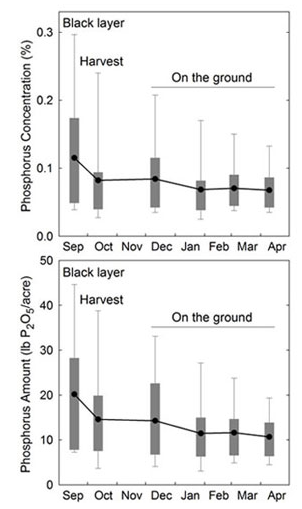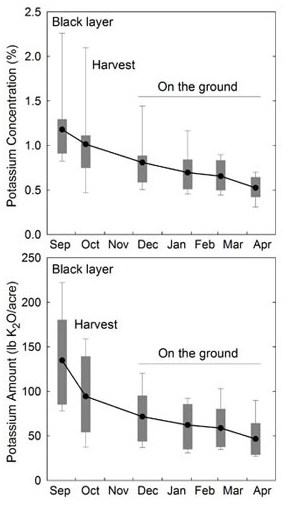|
|
Questions about phosphorus and potassium concentrations in cornstalks
Increasing corn yield and harvest of cornstalks for feed, bedding or bioenergy production are generating numerous questions about phosphorus (P) and potassium (K) concentrations in cornstalks and removal.
The functions of P and K in plants influence their accumulation in different plant parts, and also may influence the magnitude of losses from live tissue or residue. A larger proportion of the total plant P is in grain compared with K, and most of the absorbed P is incorporated into the plant organic matter but K is in the inorganic soluble ion form.
Therefore, P and K amounts removed by cornstalk harvest, concentrations and recycling to the soil may vary and over time be affected by rainfall and other factors. Also, high temporal soil-test variation, mainly for K, points to a potentially important effect of P and K recycling.
Summary of ongoing research
A study has been investigating P and K uptake by corn and soybean, removal with grain harvest, and recycling. This article summarizes results for cornstalks from nine fields that were sampled in 2009 or 2010.
Aboveground plant samples collected at the black layer stage were separated into grain and vegetative portions (cobs, stalks and leaves). At grain harvest time, residue was placed in mesh plastic bags on top of no-tilled ground, which were removed at about 45 day intervals until the following spring. All samples were analyzed for P and K concentration and accumulation.
Figure 1 shows the P concentrations and amounts in corn tissues (except grain) from the black layer stage until spring of the following year.
|
|
On average across fields, the P levels decreased until the time of grain harvest, remained the same until late fall, decreased again until mid winter, and thereafter remained about the same. The amount of P in residue at grain harvest was 69 percent of the amount at the black layer stage, and by April the amount remaining in residue had decreased to about one-half (53 percent).
Figure 2 shows that the trends over time for both K concentration and amount differed from trends observed for P. The K levels decreased sharply from the black layer stage until the time of grain harvest, during the fall, during early winter and in spring. Only during late winter there was no significant K loss.
The amount of K remaining in residue at grain harvest time was 69 percent of the amount at the black layer stage (proportionally similar to the value observed for P), by late fall the amount remaining in residue was 59 percent, and by April had decreased to 38 percent.
The magnitude and distribution of tissue P and K loss increased with increasing precipitation, but this was more consistent for K than for P. Moreover, increasing rainfall from black layer to late fall increased significantly the K loss but not the P loss (not shown). There was large variation in the P and K concentrations and amounts in cornstalks across the sites, but mainly from the black layer stage to late fall. This high variation resulted from differences in soil-test levels, fertilizer rates, hybrids, rainfall and other growth conditions. Contamination with soil and loss of leaves due to wind, which can affect P and K residue concentrations, were not factors influencing the results in this study but may become relevant when working with farm equipment.
The bottom line
Nutrient loss between the black layer and harvest was large for both P and K, loss from cornstalks between harvest and late fall were large only for K, and the overall proportional loss by spring was greater for K. The average P and K concentrations and removal shown in this article, related publications and articles can be used as a general guideline, but due to large variation across fields and years sampling and analysis of harvested cornstalks is recommended to adequately estimate values.

 Figure 1. Phosphorus concentration and amount in corn vegetative tissue at black layer and residue as a function of time. Solid boxes encompass lower and upper 25 percent percentiles, whiskers indicate minimum and maximum values, and black dots joined by a line represent average values.
Figure 1. Phosphorus concentration and amount in corn vegetative tissue at black layer and residue as a function of time. Solid boxes encompass lower and upper 25 percent percentiles, whiskers indicate minimum and maximum values, and black dots joined by a line represent average values.





Post a comment
Report Abusive Comment